When choosing a four-person tent, focus on its intended use, weight, weather resistance, key features, and cost. To improve your camping experience, look for extended dome designs, room dividers, vestibules, and advanced weatherproofing options.
Choosing the right Tent for your trip is very important to make it successful, so do enough research before purchasing. This guide specifically targets four-person tents and provides all the critical information to consider.
Use the insights on How to choose 4 person tent from this guide to help you pick the perfect Tent for your next adventure!
Key Considerations when Choosing a Four-Person Tent
Here are some crucial questions you need to ask yourself before getting into any specific models to determine the best 4-person Tent suited for your needs:
What Type Of Camping Will You Be Doing?
Backpacking:
If you plan on backpacking, prioritize lightness and compatibility; lightweight tents thus become necessary.
Car Camping:
Comfort and space are more important for car camping. You can afford a slightly heavier tent with more features, as you can transport it by car.
What Weather Conditions Will You Encounter?
Three-Season Tents: These tents are meant for use from spring to fall. They’re built to withstand severe weather but are still well-ventilated for summer heat.
Four-Season Tents: These tents provide good cover against snow and high winds for winter camping and challenging weather conditions. However, they tend to be heavier and less airy, so they may not be appropriate for summertime or light backpacking.
What Is Your Budget?
Budget Tents ($70 – $130) are basic shelters with no frills that aren’t very durable or weather-resistant. They work for an occasional trip but won’t hold up in rough conditions.
Mid-Range Tents ($130 – $270): These have multiple windows, easy setup, and extra storage.”In terms of durability, weatherproofing, and additional features such as multiple windows, ease of setup, and extra storage, these make great choices.
More Expensive Tents ($300+): These tents have advanced materials and innovative designs, including ultralight and four-season options. They are best used by hard-core campers who require specific gear for severe climates. These tents are generally less multipurpose but unbeatable in particular conditions.
Your budget will depend on how frequently you plan to use the Tent and what type of camping you will do. Considering these factors, you may find a tent that suits your needs and guarantees a memorable camping experience.
Types of Four-Person Tents
To choose the right 4-person Tent, it is important to understand the different types available and what makes them ideal or not. Here are the main classifications:
Dome Tents
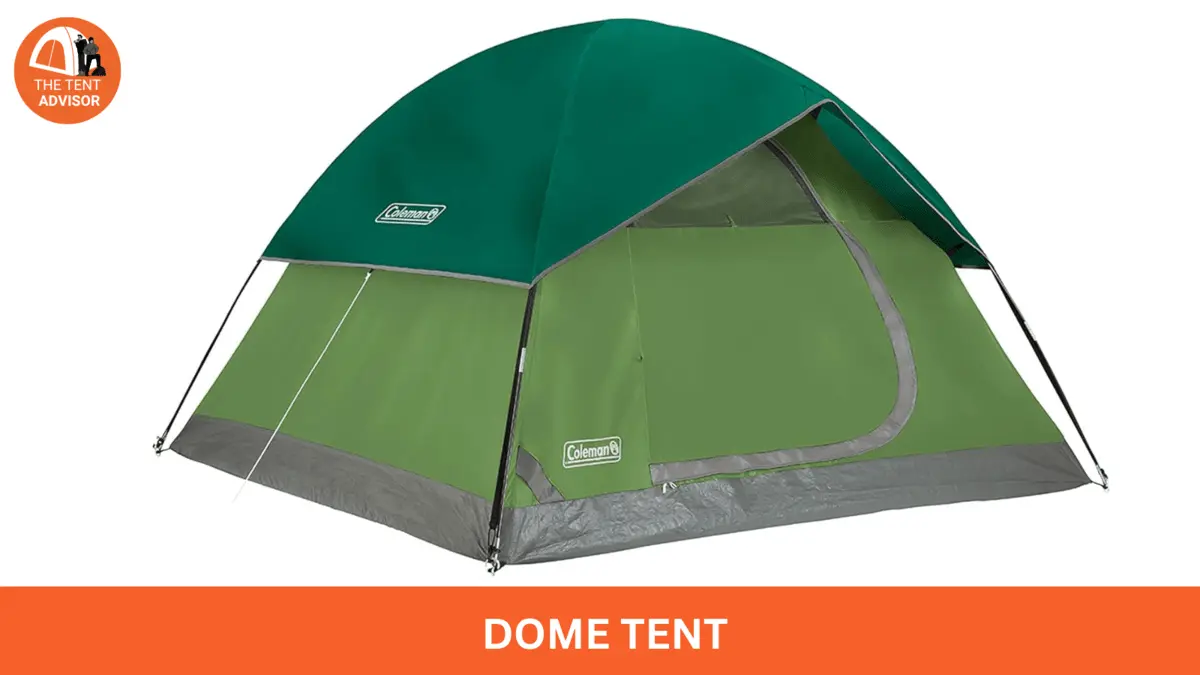
Summary: They have a rounded top that resembles a dome and two crossing poles, making them solid and sturdy. These tents are famous for general camping activities and come in different designs.
Benefits:
Wind Resistance: Because they look like domes, dome tents can withstand wind better than any other type of Tent.
Ease of Installation: Simple design leads to quick and straightforward assembly.
Variety: Many styles and features are available, from fundamental to advanced models.
Be Aware:
Low Ceiling: The low ceiling restricts headspace.
Limited space inside:
These tents do not have much room for packing gear and may be uncomfortable if you want a place to sit around or sleep.
Cabin / Lodge Tents
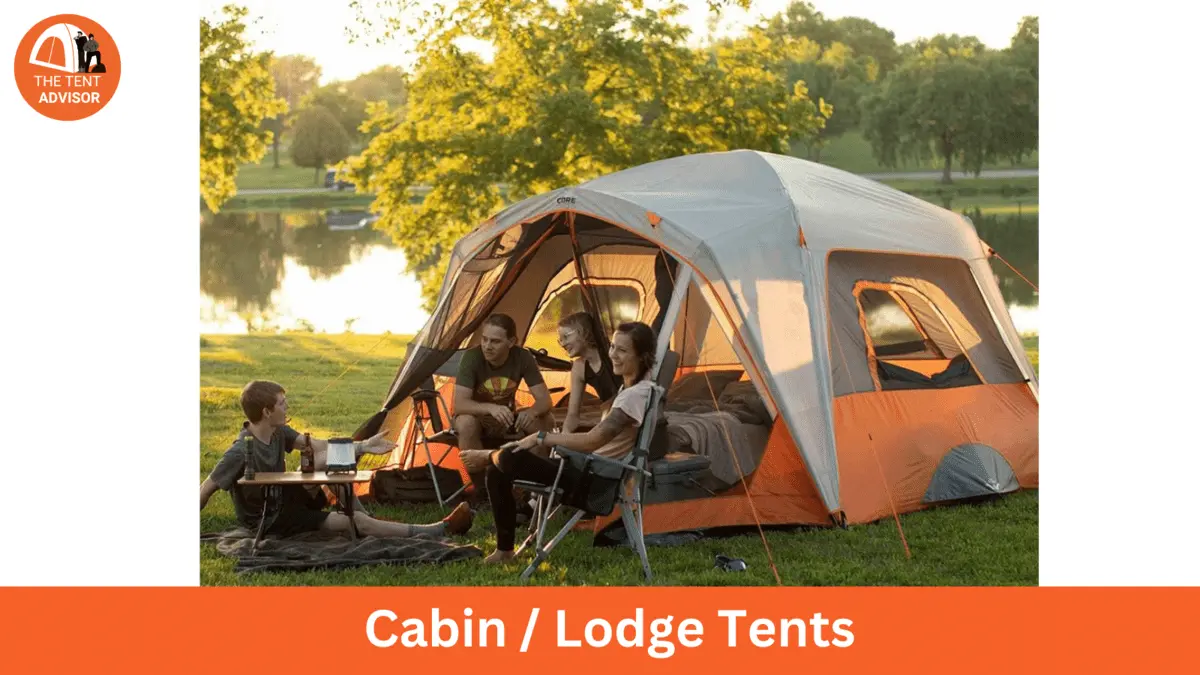
Summary: Cabin tents feature straight walls and high ceilings, which sometimes resemble a diminutive cabin. Such designs offer plenty of internal space and, therefore, suit people with families or groups requiring more space.
Benefits:
Spaciousness: High ceilings and vertical walls create a roomy interior.
Privacy: Some models have dividers for privacy within the tent space itself.
Ventilation: Large windows and doorways enhance airflow, reducing stuffiness.
Be Aware:
Bulkiness: Heavy and cumbersome, making them difficult to carry around.
Complex Setup: Often requires more effort and can be set up by one or more persons.
Wind Resistance: The height of these structures makes them more susceptible to wind.
Backpacking Tents
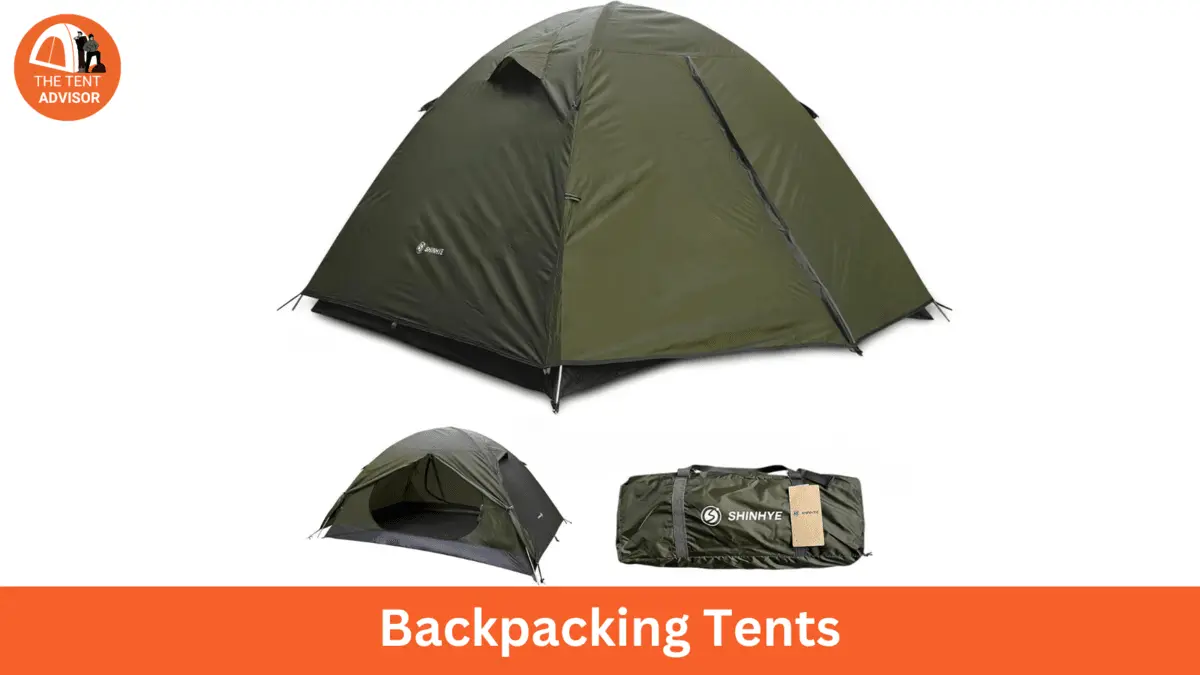
Description: These tents are designed for people who travel long distances and need lightweight shelter. They are easy to transport and still protect from the natural elements.
Benefits:
Lightweight:
They are not heavy, so they are easy to carry over long distances and load into backpacks.
Compact Design: It occupies less space in your backpacking gear.
Be Aware:
Limited Space: They are often not as roomy or comfortable as other types because they are made with lightweight materials in mind.
Higher Cost: Usually extra expensive due to their reliance on state-of-the-art materials and technology
Different Tent Designs and Their Size Options
The overall size and space of a 4-person tent are heavily influenced by its style. Here are some of the popular styles.
- Pop-up Tent for Four People: These tents are known for their quick setup, which usually unfolds within seconds. They have a small footprint, making them great for short trips or festivals; however, they may provide less space and fewer features than other tent styles.
- Four-Season Tent: Manufactured to be usable in all weather conditions, four-season tents are made of strong materials that can withstand extreme weather. Often, these tents offer more sturdiness and space, which is appropriate for extended stays or harsh environments.
- 4-man Tent with Porch: These tents have an integrated porch or vestibule, which gives you more room for equipment storage and relaxation. They are ideal for family camping or extended expeditions where extra storage and living areas are needed.
Understanding the types will help you choose the best Tent that fits your camping style and needs. There is a four-person tent that suits your requirements, regardless of whether you value ease of setting up, spaciousness, or lightweight portability.
Characteristics to Consider While Buying a 4-Person Tent
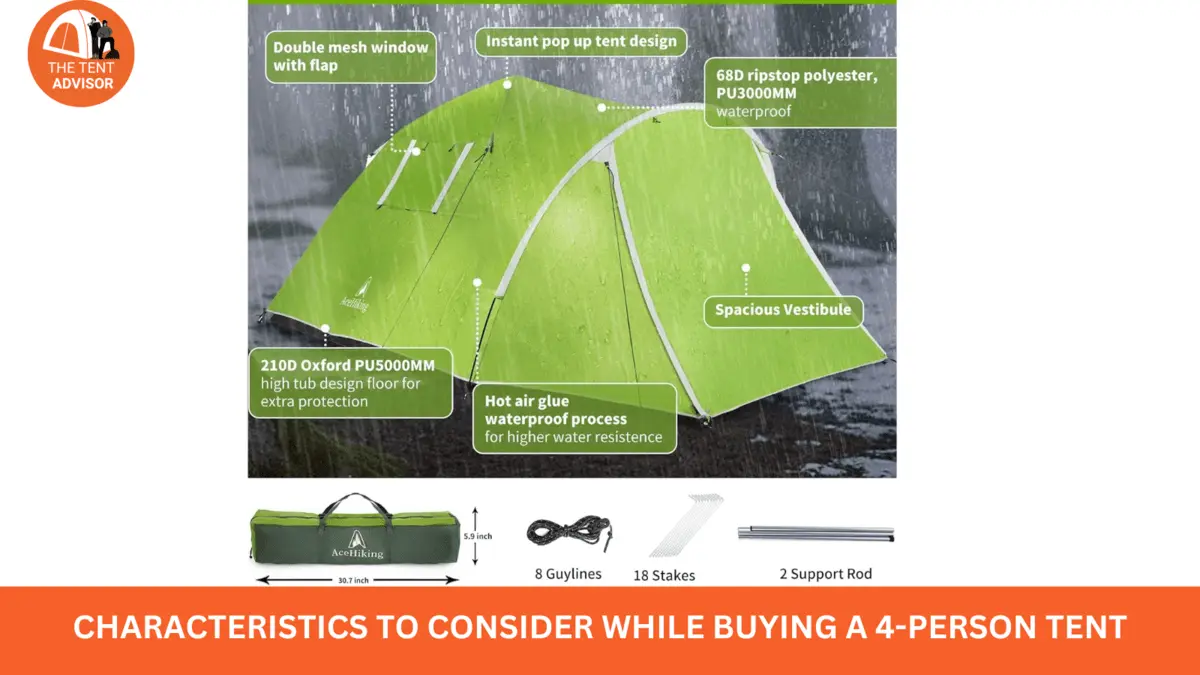
Numerous features available in different tents can make your camping experience more enjoyable. Here is a list of critical factors:
Bonus Space
Definition: Vestibules are the outside areas located next to the Tent and usually covered by rainflies. They are where you can store shoes and gear items while keeping them safe from exposure to the elements.
Advantages: This helps increase room for additional camping equipment without crowding inside.
Inside Stowage
These are provided for inside pockets and gear lofting in the Tent.
Advantages: Such storage facilities help keep your camping shelter well-organized besides enabling easy access to crucial things such as flashlight batteries, car keys or other personal effects.
Additional Waterproofing Characteristics
Look for attributes like waterproofing coatings, bathtub floors or sealed seams.
Advantages: This will ensure that any heavy downpour does not find its way into the Tent through some weak points, thus maintaining its dryness.
Easy-Pitch Features
It may have colour-coded poles, pre-attached poles or quick-clip systems.
Benefits: This simplifies and accelerates setting it up, meaning you’ll spend fewer minutes pitching the item and more time outdoors enjoying your journey.
More than one door
Some tents have multiple entrances across the two vertical edges or through the front and rear.
Advantage: It ensures good aeration, prevents disturbance of other occupants, and assists you in coming in and out without struggle during darkness.
Ventilation Systems
Windows with mesh screens as well as roof vents.
Benefit: It acts as a breeze that builds up less moisture inside your Tent, keeping the internal atmosphere cool.
Reflective Details
Consists of reflective zipper pulls, guy lines, and tent edges.
Benefit: Night-time visibility increases, and tripping over guy lines can be prevented, improving the tent area’s safety.
Be Aware:
When choosing a lightweight and compact tent, keep in mind:
Limited Space and Comfort:
These are made to be as light and small as possible; hence, they may not offer the same amount of room inside or the level of comfort provided by grander models.
Higher Cost: They usually employ advanced materials and technologies, making them more expensive.
Wind Resistance:
Verify that the Tent can endure high-speed winds. Check out reinforced seams, guy ropes, etc., which increase stability.
Ventilation and Condensation Control
Airflow: Proper ventilation minimizes condensation, providing comfort. Selecting tents with mesh panels, roof vents, or wall vents will improve airflow, reducing humidity in a tent.
Simplifying the Process of Pitching
How to set up: Find tents with easy installation, such as poles that are color-coded or have pre-attached sections. This can help you pitch your Tent much faster.
Pole Material: Use high-quality materials such as fibreglass or carbon fibre to enhance the strength and durability of a tent structure.
Portability: Ensure it is lightweight and has a compact carrying bag for easy transportation.
The Durability and Quality of Materials Used
Fabric: Tents should be made of fabrics with good abrasion resistance, such as ripstop polyester or Dyneema Composite Fabric. These fabrics will also provide water resistance and prevent them from being easily torn.
Poles and Guy Ropes: Tents should have solid and flexible poles (either aluminium or fibreglass) and strong guy ropes for firmness against bad weather conditions.
Internal Storage: Pockets and gear lofts help keep everything in place while making it easy to access valuables like headlamps or keys.
Multiple Doors: Such tents have better ventilation and accessible entrances at night.
Reflective Details:
Improve your visibility at night by adding reflective zipper pulls and guy lines so that tripping on guy lines will not occur.
Internal Space:
Consider the Tent’s internal dimensions to ensure enough room for four people and their gear. Consider sleeping space and the ability to move around.
Airflow:
Proper ventilation minimizes condensation, providing comfort. Selecting tents with mesh panels, roof vents, or wall vents will improve airflow, reducing humidity in a tent.
Simplifying the Process of Pitching
How to set up: Find tents with easy installation, such as poles that are color-coded or have pre-attached sections. This can help you pitch your Tent much faster.
Pole Material: Use high-quality materials such as fibreglass or carbon fibre to enhance the strength and durability of a tent structure.
Portability: Ensure it is lightweight and has a compact carrying bag for easy transportation.
The Durability and Quality of Materials Used
Fabric: Tents should be made of fabrics with good abrasion resistance, such as ripstop polyester or Dyneema Composite Fabric. These fabrics will also provide water resistance and prevent them from being easily torn.
Poles and Guy Ropes: Tents should have solid and flexible poles (either aluminium or fibreglass) and strong guy ropes for firmness against bad weather conditions
How should one pick the right 4-person Tent?
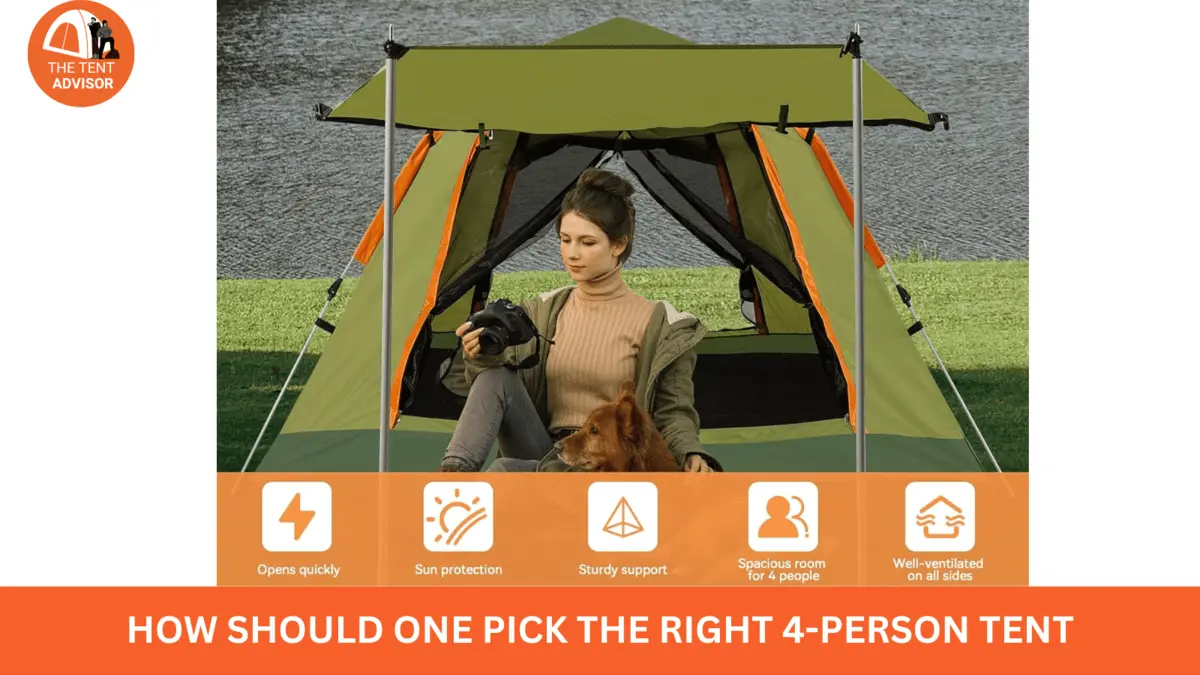
The following are some scenarios that can help you decide on a good camping tent:
For Backpacking:
Needs: Lightweight and compact design, high durability, extra waterproofing.
Recommended Tents: Consider Big Agnes Copper Spur HV UL 4, MSR Elixir 4, or Coleman Peak1 4-Person Tent.
For Family Camping:
Needs: Cabin style with high ceilings, room dividers, easy setup, and durable materials.
Recommended Tents: Consider Nemo Wagontop 4P, Eureka! Copper Canyon LX 4, or Big Agnes Big House 4.
For Festival Camping:
Needs: Good ventilation, awning or large vestibule, budget-friendly.
Recommended Tents: Try Coleman Skydome™ 4-Person Camping Tent with Full-Fly Vestibule, Eureka! Timberline SQ 4XT or Kelty Rumpus 4.
2 Person VS 4 Person Tents
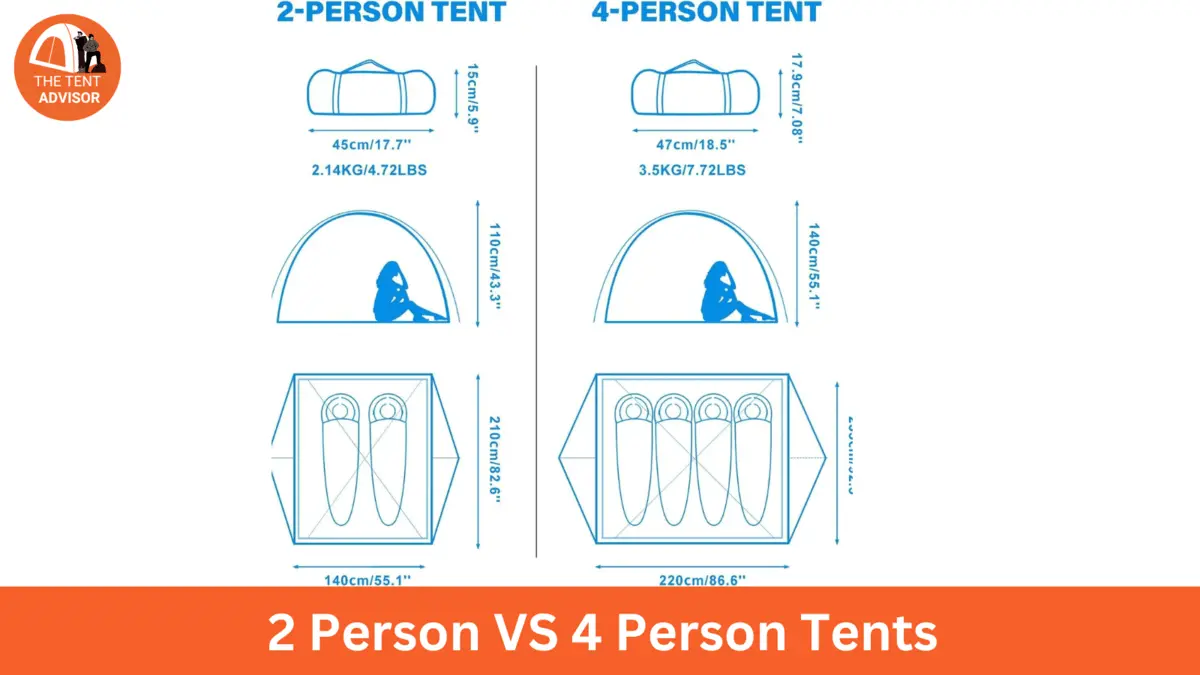
The decision as to whether to choose between a 2P (2-person) or 4P (4-person) solo hiking / backpacking shelter depends on several things:
2-Person Tent:
Pros:
Compact and Lightweight: This is simpler, especially during hikes or backpacking. It can fit in crowded campsites.
Easier to Set Up: This relatively simple setup procedure takes less time, too.
Cost-Effective: They are generally cheaper compared to larger ones.
Sufficient for Solo Camping: It has enough room for you and your stuff, though it may feel cramped.
Negatives:
Limited space: It feels small with all your stuff in it; less stretching room.
Limited headroom: Sitting up or changing clothes is difficult because of the limited space.
Insufficient airflow/ventilation: It can get stuffy inside, especially on a warm day.
4-person Tent:
Positives:
Roomy: There is plenty of room for you and your belongings, so you will not feel crowded. You will have enough room for movement.
Cosy: This Tent is comfortable for an extended period if you have many items like this one.
It is more suitable for Car Camping, for instance, when one is closer to a vehicle, and weight does not matter much.
Disadvantages:
Heavy and bulky: If not car camping, it may be uncomfortable while being carried. They are also more complicated to set up by yourself alone.
Too big for solo camping trips: With such a spacious shelter, unused spaces may remain on the trail most nights.
Potential heat loss: Although tents can retain warmth better than open-air spaces, larger tents take longer to heat up due to the bigger volume of air occupied, which needs warming more than smaller tents.
Frequently Asked Questions (FAQs) Concerning the Best Four-Person Tents
What should be considered when purchasing a 4-person tent?
Price, comfort, space, seasonality, weight, portability, and ease of setup are some factors to consider when buying a four-person tent. These components collectively shape the entire camping experience.
How big does the Tent have to be for four people?
Choose a tent that offers sufficient sleeping space and space for personal items for four individuals. The Tent must have enough room to ensure comfort.
Which are the best materials for a durable four-person tent?
Polyester is frequently chosen for its durability compared to nylon. Another great option is Dyneema Composite Fabric due to its high tensile strength, lightness and waterproofness.
What accessories do I need for a 4 person tent?
Add reflective zipper pulls to increase visibility and ease of use. Other useful accessories include sleeping bags, blankets, pillows, air mattresses, lanterns, tarpaulins, and extra batteries.
How to choose 4 person tent- Final Verdict
Ideal 4-person tents should have plenty of space, good ventilation, weatherproofing, and easy assembly while being durable and lightweight.
How to choose a four-person tent: The answer lies in Knowing your camping requirements, evaluating sleeping areas and comfort, considering gear storage and living space, looking at different types of tents, and comparing dimensions and floor plans. This will enable you to get the best four-person Tent for all the expeditions you plan on undertaking.
If you take the time to decide between a four-person quick-pitch tent, a four-season tent, or a four-person tent with a porch, you will considerably elevate your camping experience and create memorable moments.
Also Read
